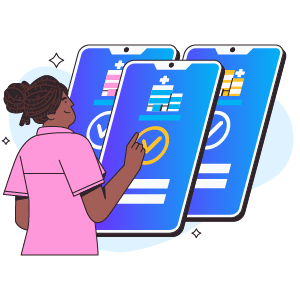Career Resources / How to Ace the Adult CCRN Test
You may be the most observant, compassionate, and effective nurse in your critical care unit, but without your CCRN certification, you’re a lot less likely to get ahead, or even to get the pay that you deserve. Being board certified by the American Association of Critical-Care Nurses brings increased respect and opportunities, but the path to certification isn’t easy. Even after you’ve put in the hours and met all the hands-on requirements, you still need to pass the certification test.
Ask anyone who’s already taken the Adult CCRN and they will tell you it’s a challenge. It’s made up of 150 multiple-choice questions that cover every bodily system, as well as the most important principles of nursing care and ethics. Even if you are a natural at taking tests, you need to prepare, and that means intensive study and then testing your comprehension and retention of what you’ve learned with plenty of Adult CCRN practice questions and practice exams.
Get job matches in your area + answers to all your nursing career questions

How Hard is the Adult CCRN Exam?
The statistics don’t lie. According to the American Association of Critical-Care Nurses, roughly one in three nurses who take the Adult CCRN Exam don’t pass. Not only does that mean that they have to take it again, but they also have to pay the exam fee again to do so – that’s $250 for AACN members or $365 for non-members.
2021
Source: AACN
The difference between those who passed and those who didn’t? Dedication to preparation. Most of the test takers who successfully passed the Adult CCRN said that they’d spent at least two months studying, going over the material that they knew would be covered and then testing themselves repeatedly with practice test questions.
Why Use Adult-CCRN Practice Questions to Study
The Adult CCRN exam is a three-hour timed test that gauges both what you know and how well you are able to put what you know into practice. But knowledge isn’t necessarily enough to help you pass the test. You also need to be familiar enough with the format of the questions and how long it will take you to answer them to approach the exam with confidence. That’s why practice questions and exams are so helpful. They demonstrate the types of questions and answer choices that will be offered, help you see which areas are your strongest and which you need to spend more time studying, and prepare you for the physical act of sitting and taking a long exam.
How to Use Adult CCRN Exam Practice Questions
Every practice question will be structured in the same way as the exam itself: with a detailed question followed by four possible answers. After you’ve answered each practice question you will be provided with the correct answer and a full explanation. If you take a full practice exam, you’ll be able to score your performance and see which areas you can feel confident about and which questions you were uncertain about, and need more study time.
The more practice questions you answer, and full practice exams that you take, the more prepared you will be, and the more comfortable and acclimated to the time and attention needed to answer 150 questions in one sitting.
Adult CCRN Practice Questions:
1. A patient displaying disordered perception and attention and memory impairment is best described as suffering from:
- delirium
- dysthymic disorder
- attention-deficit-hyperactivity-disorder (ADHD)
- dementia
Answer: A – Delirium
Explanation: Delirium is an acute disorder. It is characterized by perception, attention, and memory impairment. It is frequently symptomatic of underlying conditions including medication overdose, substance intoxication, dementia, and electrolyte disorders.
2. Which of the cranial nerves listed below has neither a sensory nor a motor function involving the eyes?
- abducens nerve
- trochlear nerve
- hypoglossal nerve
- oculomotor nerve
Answer: C Hypoglossal nerve
Explanation: The hypoglossal nerve (cranial nerve XII) has a motion function involving movement of the tongue. The others each have motor function involving eye movement, with the trochlear nerve (cranial nerve IV) involving eye movement, the abducens nerve (cranial nerve VI) having a sensory function involving eye movement, and the oculomotor nerve (cranial nerve III) having a motor function involving eye movement and contraction of the iris.
3. What should a patient with severe SIADH be treated with?
- Hypertonic saline
- Normal saline
- D5 ½ NS + 20mEq/KCL
- D5W
Answer: A – Hypertonic saline
Explanation: Patients with severe SIADH (too much water/dilutional hyponatremia) need hypertronic fluids to correct their electrolyte imbalance. Hypertonic saline contains more (hyper) salt or sodium than normal saline.
4. An Intra-aortic balloon pump inflates at which of the following cardiac cycle phases?
- Beginning of ventricular diastole
- Beginning of ventricular depolarization
- Beginning of ventricular diastole
- End of ventricular diastole
Answer: C – Beginning of ventricular diastole
Explanation: The balloon pump has to inflate when the heart relaxes – ventricular diastole – in order to augment diastolic pressure and improve coronary blood flow. It deflates when the heart contracts – ventricular systole – thus helping reduce afterload and improving cardiac output.
Get job matches in your area + answers to all your nursing career questions

